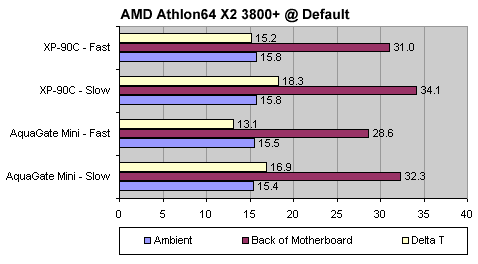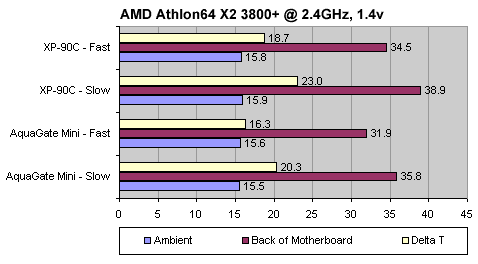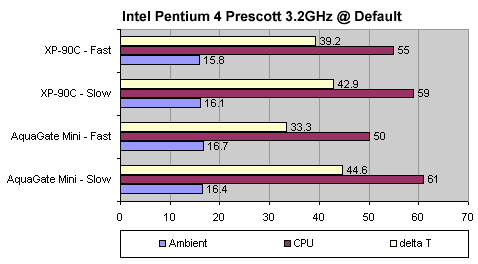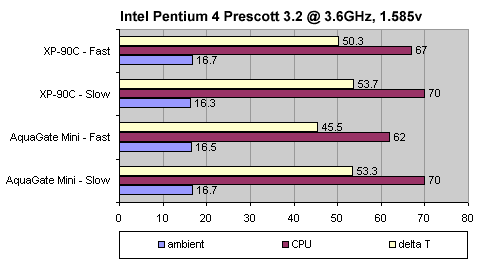|
|
|
|
|
Cooler Master AquaGate Mini R120 |
|
Join the community - in the OCAU Forums!
|
Performance Comparison and Conclusions
Performance Comparison:
The testing is essentially identical to that seen in our recent Thermalright XP-90C review. In fact, we'll be using that cooler as a basis for comparison. The XP-90C showed itself to be among the top-flight air-coolers, so beating it should be a worthy challenge for this liquid-based cooler. For both coolers we used Thermalright's thermal paste. The default fan was used on the AquaGate Mini of course, while for the XP-90C we used the Sunon KD1208PTBX-6A "X-series" 80mm unit.
First up, our S939 Athlon64 X2 3800+ at the stock speed of 2.0GHz and the stock 1.325v core voltage. Protac recently sent over ECS's NFORCE4-A939 motherboard, but the CPU temperature sensor seems flaky, reporting very different values each time it's checked in MBM, SpeedFan or Sandra. Even NVIDIA's nForce Monitor won't pick up the sensor, only reporting a "System" temperature which doesn't fluctuate enough under load to be from the CPU. So for this motherboard we'll use a thermal probe secured to the back of the motherboard, held in place with a small square of foam and some sticky-tape. Not very high-tech, but it'll suffice for our testing. The thermal probe is monitored by our trusty DigiDoc 5, which is also used to record the ambient temperature. The coolers were tested with the motherboard sitting on a bench, outside a case.
We're not too interested in idle temperatures, so only full-load tests were done. Two instances of Folding@Home were used to load up both cores of this dual-core CPU. After 15 minutes the temperatures were recorded, with both coolers taking less than 10 minutes to reach a stable temperature.

The important number is Delta T, the difference between the ambient and recorded temperatures. At default speed and volts our Manchester-cored CPU isn't putting out much heat. Still, we see the AquaGate Mini beat the XP-90C by a handy couple of degrees. So, next we boost the speed to 2.4GHz and the core voltage to 1.4v from the default 1.325v.

Again there's about two degrees or so in it, with the AquaGate Mini the victor. We'll switch to our firebreathing Prescott P4 to see if a higher heat load gives us any more info. In this setup we're using an ABIT IC7 which is happy to report CPU die temperature to MBM. We'll still use the DigiDoc5 to report ambient temp. Two instances of Folding@Home were used in the background, and given we have a decent video card in this system we'll run two full loops of the 3DMark2001SE benchmark as well, recording the temperatures at the end of the second loop. This time the system was tested while fully installed in the Yeoh Chih server case, but with the case side open.

In slow mode the XP-90C leads by a couple of degrees, but remember these are full-load temperatures, so the slow mode isn't that relevant. Once there's some decent airflow the AquaGate handily beats the aircooler. Let's crank up the speed and volts.

Even with the heat load from an overclocked and overvolted Prescott P4, the AquaGate Mini R120 outperformed the XP-90C, the best aircooler we've tested so far, by about 5 degrees. Since the XP-90C came out there have been a few more high-end coolers released, but it's certainly fair to say the AquaGate will be well up there with, if not better than, the absolute best air-coolers.
There's another factor that we didn't really examine too closely because it varies so widely from system to system, and we were primarily interested in comparing the relative performance of the coolers themselves. But, one huge advantage the AquaGate Mini has over any aircooler is that it can be configured to draw ambient air through the radiator. The best aircooler in the world is going to have a difficult time if it's sitting in a pocket of warm air inside a case. Even in a poorly-ventilated case with a firebreathing video card right below the CPU, the AquaGate will be using air from outside the system to exchange heat with, while it's likely the XP-90C and similar coolers would suffer. That's one of the fundamental advantages that liquid-coolers have over air-coolers and something you can definitely experience with this cooler.
Conclusions:
Overall this is quite an impressive unit. It doesn't have perhaps the "street cred" of building a watercooled system out of components you select yourself, but in terms of sheer convenience it's hard to beat. Only barely more difficult to install than a high-end aircooler, it offers superior performance and the ability to run virtually silently. A quick sniff around shows it costing around AUD $120 on the street, which isn't much more than a high-end aircooler with fan nowadays - and it's significantly cheaper than the older AquaGate. The R80 model with 80mm fan and radiator is cheaper again.
|
|
Advertisement:
All original content copyright James Rolfe.
All rights reserved. No reproduction allowed without written permission.
Interested in advertising on OCAU? Contact us for info.
|

|


